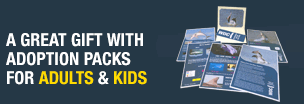
Bubbles
I’m Bubbles, I have a wide range and can be seen throughout the Port River and the Adelaide Dolphin Sanctuary. I am often seen with my best mate Lunar.
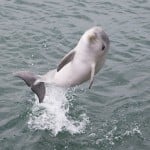
Ali
I’m Ali, I survived after being made an orphan after eight months. You can often see me bow riding in front of tugs on the River.

Rocket
I’m Rocket, after being orphaned after 7 months, I am now healthy and active and can be found in the Inner Port.

June
I’m June. Originally from the Port River, I can be seen often in the Patawalonga Lake, which I enter via the boat lock.
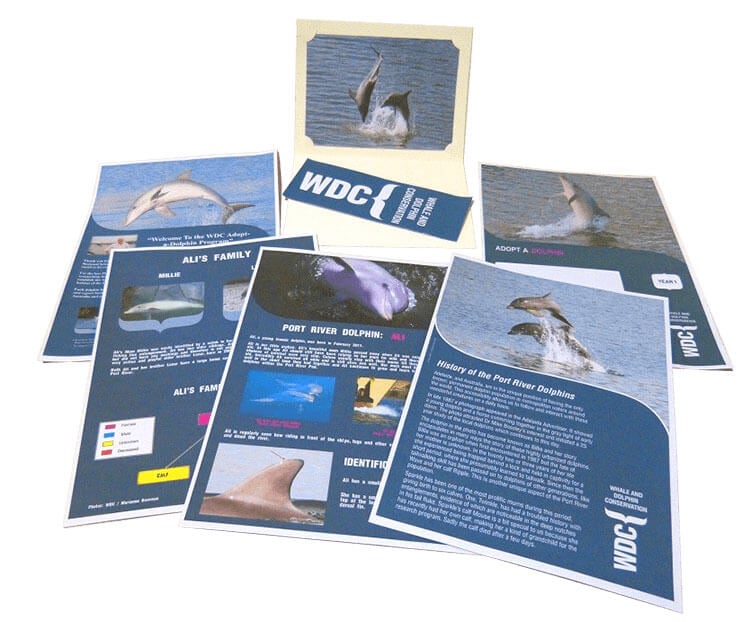
WHEN YOU ADOPT A DOLPHIN YOU’LL RECEIVE THIS PACK
- A personalised adoption certificate featuring a picture of your adopted dolphin and
some personal characteristics. - An A5 sized colour photo of your adopted dolphin.
- An information sheet of the dolphin, including photo identification and the
dolphin’s family tree. We will also include a history of the Port River population. - A WDC adoption car sticker or a special sticker sheet for under 14’s.
And lots of information about how your adoption will help WDC protect dolphins.
You will also receive a quarterly e-newsletter updating the progress of your adopted dolphin, with recent photos and all the news of the local population and cetaceans generally.
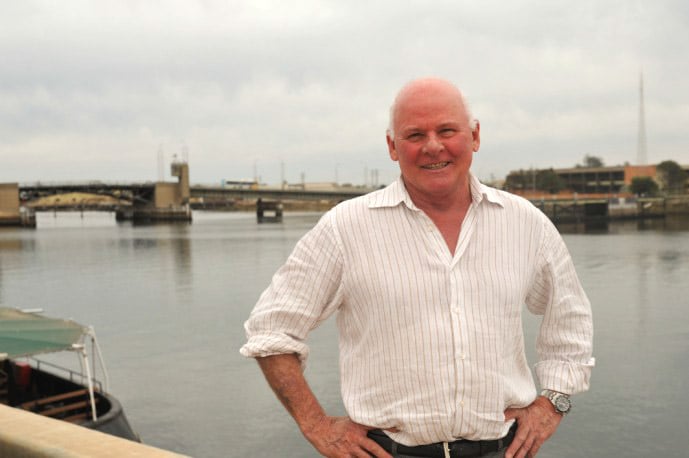
The dolphins of the Port River in Adelaide are the first known permanent resident population in a metropolitan area. Dr Mike Bossley and his team of volunteers have been studying them for longer than 30 years and have a unique understanding of their personal behaviors and the habitat they survive in. Port Adelaide is a working port, and as such places pressure on the local dolphins from shipping, industrial activity and recreational fishing. When you adopt a dolphin you will build a special link with an individual and help us to protect the whole population and give them a safer future.
Keep up to date with the latest news on the dolphins by following our dedicated Facebook page.
In late 1987 a photograph appeared in the Adelaide Advertiser. It showed a young dolphin and a horse swimming together in the gray light of early dawn. The photo attracted Dr Mike Bossley’s interest and initiated a 34 year study of the local dolphins which continues to this day. The accessibility of the local population allows us to follow and interact with these wonderful creatures on a daily basis.
Following years of lobbying by Mike and others, the Port River and its environs have been declared a Dolphin Sanctuary. The Sanctuary is regularly patrolled by government rangers, supported by a committed group of volunteers. There have been stabbings, shootings, boat strikes and entanglements. We cannot relax in our attempts to protect these dolphins and the environment on which they depend.
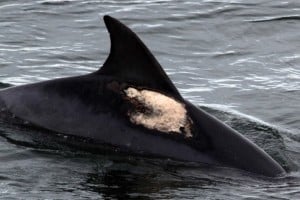
Mike’s patient, non-invasive study over the years has revealed that about 30 dolphins call the Adelaide Dolphin Sanctuary home. An equal number visit regularly, and a further 100 are occasional visitors. Being a permanent, metropolitan population in a working port brings a number of perils to a dolphins life. Some are deliberate; such as shootings, stabbings and boat strikes, and some are accidental; such as entanglements and boat impacts. Industrial activity and pollution runoff also offer threats
to the dolphins and their habitat.
As well as Mike’s observations and data collection, WDC works closely with the Adelaide Dolphin Sanctuary Action Group who assist the Sanctuary rangers in watching over the local population. The Action Group conducts land and water-based surveys, community engagement over specific issues, educational programs, and stranding and entanglement incidents. A good example of this was with the recent concern over people feeding dolphins, causing behavioural changes that can lead to death. Group volunteers placed signs, spoke to individuals and distributed leaflets to deter the harmful practice.

While research and patrolling remain a priority for WDC in the Adelaide Dolphin Sanctuary, areas for future development include a comprehensive water testing program for the Port River, improving industrial and stormwater runoff and educating on the need to follow the required boat speeds.
Another requirement for the Sanctuary is the establishment of a Dolphin Interpretive Centre on the banks of the Port River. An interpretive centre is needed to further educate the public on the need to protect our dolphins and to provide increased security through a system of outdoor cameras.

The success of the Adelaide Dolphin Sanctuary ultimately depends on the education of residents, user groups, visitors and all people living in the stormwater catchment area. To achieve this success, and fulfil its required objectives the Sanctuary requires a public profile. A Dolphin Interpretive Centre at Port Adelaide would:
- Allow a dedicated exhibit space accommodating the general public as well as school and community groups.
- Allow for a user-friendly, interactive multimedia experience using video cameras and underwater
microphones around the sanctuary environs. - As well as being a tourist attraction in its own right, the Centre could combine with existing tourist activities, such as the dolphin cruise boats. This would help make the Centre the fulcrum for all dolphin enthusiasts in the Port region and expand these activities in a controlled fashion that would ensure the sustainable existence of the dolphin population.
- Provide a home for the storing and docking of vessels associated with monitoring and surveying of the dolphin population. At the moment, research on the river is conducted by NGO groups like WDCS, Sanctuary rangers, the SA Museum and academic institutions. The Centre would provide the opportunity to collate all this information.
- Provide space for the SA Museum’s activities with cetaceans. The State has very limited resources to treat injured or traumatised cetaceans.
The centre should provide patrons with a “dolphin’s eye” view of life in the Port River estuary. This will help people understand the threats dolphins face and help establish an emotional connection between people and dolphins. A multimedia facility incorporating an array of remote video cameras and underwater microphones spread around the Sanctuary feeding images and sound back to the Centre where visitors can experience dolphins in any specific site in ‘real time’. This technology would also double as a security device highlighting any physical threat to the dolphins or their habitat. It could also prove useful for tourism operators.
Meet the dolphins

Bubbles
I’m Bubbles, I have a wide range and can be seen throughout the Port River and the Adelaide Dolphin Sanctuary. I am often seen with my best mate Lunar.

Ali
I’m Ali, I survived after being made an orphan after eight months. You can often see me bow riding in front of tugs on the River.

Rocket
I’m Rocket, after being orphaned after 7 months, I am now healthy and active and can be found in the Inner Port.

June
I’m June. Originally from the Port River, I can be seen often in the Patawalonga Lake, which I enter via the boat lock.
What you will get

WHEN YOU ADOPT A DOLPHIN YOU’LL RECEIVE THIS PACK
- A personalised adoption certificate featuring a picture of your adopted dolphin and
some personal characteristics. - An A5 sized colour photo of your adopted dolphin.
- An information sheet of the dolphin, including photo identification and the
dolphin’s family tree. We will also include a history of the Port River population. - A WDC adoption car sticker or a special sticker sheet for under 14’s.
And lots of information about how your adoption will help WDC protect dolphins.
You will also receive a quarterly e-newsletter updating the progress of your adopted dolphin, with recent photos and all the news of the local population and cetaceans generally.
The Port River dolphins

The dolphins of the Port River in Adelaide are the first known permanent resident population in a metropolitan area. Dr Mike Bossley and his team of volunteers have been studying them for longer than 30 years and have a unique understanding of their personal behaviors and the habitat they survive in. Port Adelaide is a working port, and as such places pressure on the local dolphins from shipping, industrial activity and recreational fishing. When you adopt a dolphin you will build a special link with an individual and help us to protect the whole population and give them a safer future.
Keep up to date with the latest news on the dolphins by following our dedicated Facebook page.
In late 1987 a photograph appeared in the Adelaide Advertiser. It showed a young dolphin and a horse swimming together in the gray light of early dawn. The photo attracted Dr Mike Bossley’s interest and initiated a 34 year study of the local dolphins which continues to this day. The accessibility of the local population allows us to follow and interact with these wonderful creatures on a daily basis.
Following years of lobbying by Mike and others, the Port River and its environs have been declared a Dolphin Sanctuary. The Sanctuary is regularly patrolled by government rangers, supported by a committed group of volunteers. There have been stabbings, shootings, boat strikes and entanglements. We cannot relax in our attempts to protect these dolphins and the environment on which they depend.
How will your adoption help?

Mike’s patient, non-invasive study over the years has revealed that about 30 dolphins call the Adelaide Dolphin Sanctuary home. An equal number visit regularly, and a further 100 are occasional visitors. Being a permanent, metropolitan population in a working port brings a number of perils to a dolphins life. Some are deliberate; such as shootings, stabbings and boat strikes, and some are accidental; such as entanglements and boat impacts. Industrial activity and pollution runoff also offer threats
to the dolphins and their habitat.
As well as Mike’s observations and data collection, WDC works closely with the Adelaide Dolphin Sanctuary Action Group who assist the Sanctuary rangers in watching over the local population. The Action Group conducts land and water-based surveys, community engagement over specific issues, educational programs, and stranding and entanglement incidents. A good example of this was with the recent concern over people feeding dolphins, causing behavioural changes that can lead to death. Group volunteers placed signs, spoke to individuals and distributed leaflets to deter the harmful practice.

While research and patrolling remain a priority for WDC in the Adelaide Dolphin Sanctuary, areas for future development include a comprehensive water testing program for the Port River, improving industrial and stormwater runoff and educating on the need to follow the required boat speeds.
Another requirement for the Sanctuary is the establishment of a Dolphin Interpretive Centre on the banks of the Port River. An interpretive centre is needed to further educate the public on the need to protect our dolphins and to provide increased security through a system of outdoor cameras.
We need a Dolphin Interpretive Centre

The success of the Adelaide Dolphin Sanctuary ultimately depends on the education of residents, user groups, visitors and all people living in the stormwater catchment area. To achieve this success, and fulfil its required objectives the Sanctuary requires a public profile. A Dolphin Interpretive Centre at Port Adelaide would:
- Allow a dedicated exhibit space accommodating the general public as well as school and community groups.
- Allow for a user-friendly, interactive multimedia experience using video cameras and underwater
microphones around the sanctuary environs. - As well as being a tourist attraction in its own right, the Centre could combine with existing tourist activities, such as the dolphin cruise boats. This would help make the Centre the fulcrum for all dolphin enthusiasts in the Port region and expand these activities in a controlled fashion that would ensure the sustainable existence of the dolphin population.
- Provide a home for the storing and docking of vessels associated with monitoring and surveying of the dolphin population. At the moment, research on the river is conducted by NGO groups like WDCS, Sanctuary rangers, the SA Museum and academic institutions. The Centre would provide the opportunity to collate all this information.
- Provide space for the SA Museum’s activities with cetaceans. The State has very limited resources to treat injured or traumatised cetaceans.
The centre should provide patrons with a “dolphin’s eye” view of life in the Port River estuary. This will help people understand the threats dolphins face and help establish an emotional connection between people and dolphins. A multimedia facility incorporating an array of remote video cameras and underwater microphones spread around the Sanctuary feeding images and sound back to the Centre where visitors can experience dolphins in any specific site in ‘real time’. This technology would also double as a security device highlighting any physical threat to the dolphins or their habitat. It could also prove useful for tourism operators.
Adopt a dolphin
For just $10 a month the recipient will receive:
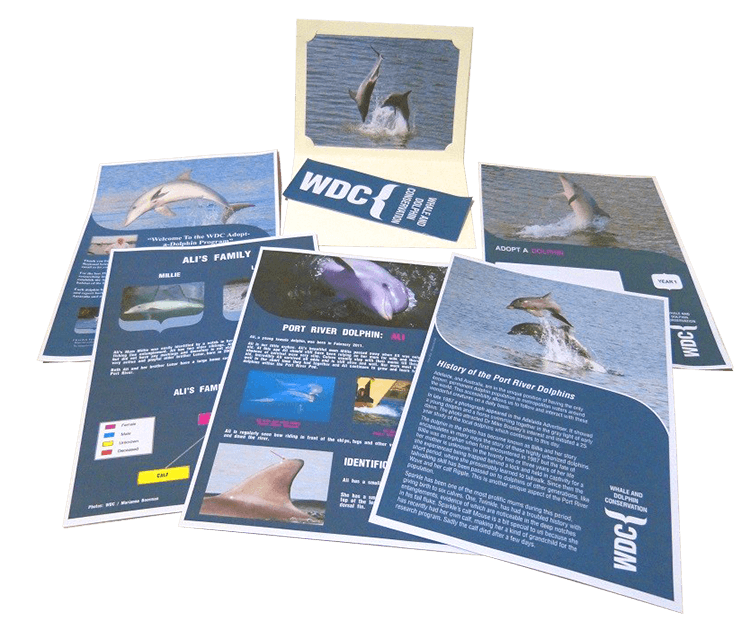
- A personalised adoption certificate
- Information on your adopted dolphin
- A colour photo of the dolphin
- A history of the Port River dolphins
- A WDC sticker
- Quarterly e-newsletter keeping you up-to-date on your adopted dolphin.
Adopt a dolphin ADOPT NOW
Make a tax free donation DONATE
Remember WDC in your Will DETAILS
Privacy policy DOWNLOAD NOW
Terms and conditions DOWNLOAD NOW

